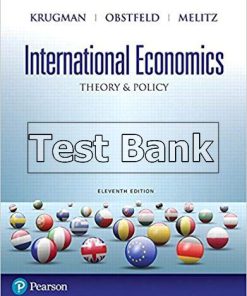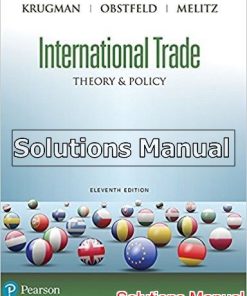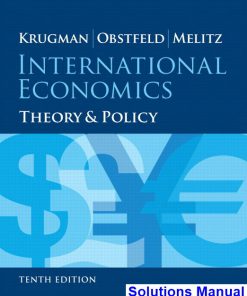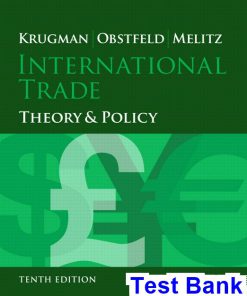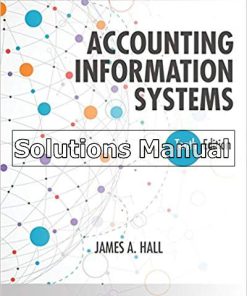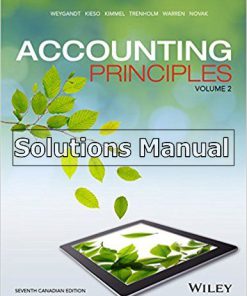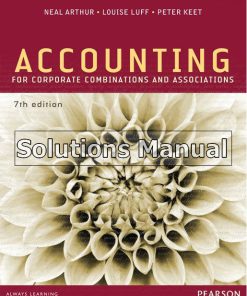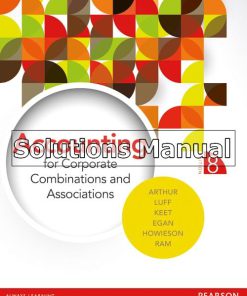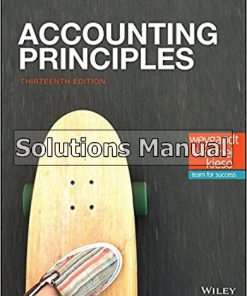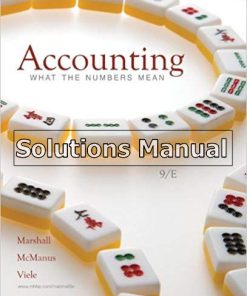International Economics Theory and Policy 11th Edition Krugman Solutions Manual
$26.50$50.00 (-47%)
International Economics Theory and Policy 11th Edition Krugman Solutions Manual.
You may also like
International Economics Theory and Policy 11th Edition Krugman Solutions Manual

Product details:
- ISBN-10 : 0134519574
- ISBN-13 : 978-0134519579
- Author: Paul R. Krugman; Maurice Obstfeld; Marc Melitz
For courses in InternationalEconomics, International Finance, and International Trade. A balanced approach totheory and policy applications International Economics:Theory and Policy providesengaging, balanced coverage of the key concepts and practical applications ofthe two main topic areas of the discipline. For both international trade andinternational finance, an intuitive introduction to theory is followed bydetailed coverage of policy applications.
Table contents:
- 1 Introduction
- What Is International Economics About?
- The Gains from Trade
- The Pattern of Trade
- How Much Trade?
- Balance of Payments
- Exchange Rate Determination
- International Policy Coordination
- The International Capital Market
- International Economics: Trade and Money
- PART 1 International Trade Theory
- 2 World Trade: An Overview
- Who Trades with Whom?
- Size Matters: The Gravity Model
- Using the Gravity Model: Looking for Anomalies
- Impediments to Trade: Distance, Barriers, and Borders
- The Changing Pattern of World Trade
- Has the World Gotten Smaller?
- What Do We Trade?
- Service Offshoring
- Do Old Rules Still Apply?
- Summary
- 3 Labor Productivity and Comparative Advantage: The Ricardian Model
- The Concept of Comparative Advantage
- A One-Factor Economy
- Relative Prices and Supply
- Trade in a One-Factor World
- Determining the Relative Price after Trade
- BOX : Comparative Advantage in Practice: The Case of Usain Bolt
- The Gains from Trade
- A Note on Relative Wages
- BOX : Economic Isolation and Autarky over Time and Space
- Misconceptions about Comparative Advantage
- Productivity and Competitiveness
- BOX : Do Wages Reflect Productivity?
- The Pauper Labor Argument
- Exploitation
- Comparative Advantage with Many Goods
- Setting Up the Model
- Relative Wages and Specialization
- Determining the Relative Wage in the Multigood Model
- Adding Transport Costs and Nontraded Goods
- Empirical Evidence on the Ricardian Model
- Summary
- 4 Specific Factors and Income Distribution
- The Specific Factors Model
- BOX : What Is a Specific Factor?
- Assumptions of the Model
- Production Possibilities
- Prices, Wages, and Labor Allocation
- Relative Prices and the Distribution of Income
- International Trade in the Specific Factors Model
- Income Distribution and the Gains from Trade
- The Political Economy of Trade: A Preliminary View
- Income Distribution and Trade Politics
- CASE STUDY : Trade and Unemployment
- International Labor Mobility
- CASE STUDY : Wage Convergence in the European Union
- CASE STUDY : Immigration and the U.S. Economy: Future Prospects
- Summary
- 5 Resources and Trade: The Heckscher-Ohlin Model
- Model of a Two-Factor Economy
- Prices and Production
- Choosing the Mix of Inputs
- Factor Prices and Goods Prices
- Resources and Output
- Effects of International Trade between Two-Factor Economies
- Relative Prices and the Pattern of Trade
- Trade and the Distribution of Income
- CASE STUDY : North-South Trade and Income Inequality
- Skill-Biased Technological Change and Income Inequality
- BOX : The Declining Labor Share of Income and Capital-Skill Complementarity
- Factor-Price Equalization
- Empirical Evidence on the Heckscher-Ohlin Model
- Trade in Goods as a Substitute for Trade in Factors: Factor Content of Trade
- Patterns of Exports between Developed and Developing Countries
- Implications of the Tests
- Summary
- 6 The Standard Trade Model
- A Standard Model of a Trading Economy
- Production Possibilities and Relative Supply
- Relative Prices and Demand
- The Welfare Effect of Changes in the Terms of Trade
- Determining Relative Prices
- CASE STUDY : Unequal Gains from Trade across the Income Distribution
- Economic Growth: A Shift of the RS Curve
- Growth and the Production Possibility Frontier
- World Relative Supply and the Terms of Trade
- International Effects of Growth
- CASE STUDY : Has the Growth of Newly Industrialized Economies Hurt Advanced Nations?
- Tariffs and Export Subsidies: Simultaneous Shifts in RS and RD 166
- Relative Demand and Supply Effects of a Tariff
- Effects of an Export Subsidy
- Implications of Terms of Trade Effects: Who Gains and Who Loses?
- International Borrowing and Lending
- Intertemporal Production Possibilities and Trade
- The Real Interest Rate
- Intertemporal Comparative Advantage
- Summary
- 7 External Economies of Scale and the International Location of Production
- Economies of Scale and International Trade: An Overview
- Economies of Scale and Market Structure
- The Theory of External Economies
- Specialized Suppliers
- Labor Market Pooling
- Knowledge Spillovers
- External Economies and Market Equilibrium
- External Economies and International Trade
- External Economies, Output, and Prices
- External Economies and the Pattern of Trade
- BOX : Holding the World Together
- Trade and Welfare with External Economies
- Dynamic Increasing Returns
- Interregional Trade and Economic Geography
- BOX : Soccer and the English Premiere League
- Summary
- 8 Firms in the Global Economy: Export Decisions, Outsourcing, and Multinational Enterprises
- The Theory of Imperfect Competition
- Monopoly: A Brief Review
- Monopolistic Competition
- Monopolistic Competition and Trade
- The Effects of Increased Market Size
- Gains from an Integrated Market: A Numerical Example
- The Significance of Intra-Industry Trade
- CASE STUDY : Automobile Intra-Industry Trade within ASEAN-4: 1998–2002
- Firm Responses to Trade: Winners, Losers, and Industry Performance
- Performance Differences across Producers
- The Effects of Increased Market Size
- Trade Costs and Export Decisions
- Dumping
- CASE STUDY : Antidumping as Protectionism
- Multinationals and Outsourcing
- CASE STUDY : Patterns of Foreign Direct Investment Flows around the World
- The Firm’s Decision Regarding Foreign Direct Investment
- Outsourcing
- BOX : Whose Trade Is It?
- CASE STUDY : Shipping Jobs Overseas? Offshoring and Labor Market Outcomes in Germany
- Consequences of Multinationals and Foreign Outsourcing
- Summary
- PART 2 International Trade Policy
- 9 The Instruments of Trade Policy
- Basic Tariff Analysis
- Supply, Demand, and Trade in a Single Industry
- Effects of a Tariff
- Measuring the Amount of Protection
- Costs and Benefits of a Tariff
- Consumer and Producer Surplus
- Measuring the Costs and Benefits
- BOX : Tariffs and Retaliation
- Other Instruments of Trade Policy
- Export Subsidies: Theory
- CASE STUDY : Europe’s Common Agricultural Policy
- Import Quotas: Theory
- CASE STUDY : Tariff-Rate Quota Origin and its Application in Practice with Oilseeds
- Voluntary Export Restraints
- CASE STUDY : A Voluntary Export Restraint in Practice
- Local Content Requirements
- BOX : Healthcare Protection with Local Content Requirements
- Other Trade Policy Instruments
- The Effects of Trade Policy: A Summary
- Summary
- 10 The Political Economy of Trade Policy
- The Case for Free Trade
- Free Trade and Efficiency
- Additional Gains from Free Trade
- Rent Seeking
- Political Argument for Free Trade
- National Welfare Arguments against Free Trade
- The Terms of Trade Argument for a Tariff
- The Domestic Market Failure Argument against Free Trade
- How Convincing Is the Market Failure Argument?
- Income Distribution and Trade Policy
- Electoral Competition
- Collective Action
- BOX : Politicians for Sale: Evidence from the 1990s
- Modeling the Political Process
- Who Gets Protected?
- International Negotiations and Trade Policy
- The Advantages of Negotiation
- International Trade Agreements: A Brief History
- The Uruguay Round
- Trade Liberalization
- Administrative Reforms: From the GATT to the WTO
- Benefits and Costs
- BOX : Settling a Dispute—And Creating One
- CASE STUDY : Testing the WTO’s Metal
- The End of Trade Agreements?
- BOX : Do Agricultural Subsidies Hurt the Third World?
- Preferential Trading Agreements
- BOX : Free Trade Area Versus Customs Union
- BOX : Brexit
- CASE STUDY : Trade Diversion in South America
- The Trans-Pacific Partnership
- Summary
- 11 Trade Policy in Developing Countries
- Import-Substituting Industrialization
- The Infant Industry Argument
- Promoting Manufacturing through Protection
- CASE STUDY : Export-Led Strategy
- Results of Favoring Manufacturing: Problems of Import-Substituting Industrialization
- Trade Liberalization since 1985
- Trade and Growth: Takeoff in Asia
- BOX : India’s Boom
- Summary
- 12 Controversies in Trade Policy
- Sophisticated Arguments for Activist Trade Policy
- Technology and Externalities
- Imperfect Competition and Strategic Trade Policy
- BOX : A Warning from Intel’s Founder
- CASE STUDY : When the Chips Were Up
- Globalization and Low-Wage Labor
- The Anti-Globalization Movement
- Trade and Wages Revisited
- Labor Standards and Trade Negotiations
- Environmental and Cultural Issues
- The WTO and National Independence
- CASE STUDY : A Tragedy in Bangladesh
- Globalization and the Environment
- Globalization, Growth, and Pollution
- The Problem of “Pollution Havens”
- The Carbon Tariff Dispute
- Trade Shocks and Their Impact on Communities
- Summary
- PART 3 Exchange Rates and Open-Economy Macroeconomics
- 13 National Income Accounting and the Balance of Payments
- The National Income Accounts
- National Product and National Income
- Capital Depreciation and International Transfers
- Gross Domestic Product
- National Income Accounting for an Open Economy
- Consumption
- Investment
- Government Purchases
- The National Income Identity for an Open Economy
- An Imaginary Open Economy
- The Current Account and Foreign Indebtedness
- Saving and the Current Account
- Private and Government Saving
- BOX : The Mystery of the Missing Deficit
- The Balance of Payments Accounts
- Examples of Paired Transactions
- The Fundamental Balance of Payments Identity
- The Current Account, Once Again
- The Capital Account
- The Financial Account
- Statistical Discrepancy
- Official Reserve Transactions
- CASE STUDY : The Assets and Liabilities of the World’s Biggest Debtor
- Summary
- 14 Exchange Rates and the Foreign Exchange Market: An Asset Approach
- Exchange Rates and International Transactions
- Domestic and Foreign Prices
- Exchange Rates and Relative Prices
- The Foreign Exchange Market
- The Actors
- BOX : Exchange Rates, Auto Prices, and Currency Wars
- Characteristics of the Market
- Spot Rates and Forward Rates
- Foreign Exchange Swaps
- Futures and Options
- The Demand for Foreign Currency Assets
- Assets and Asset Returns
- BOX : Offshore Currency Markets: The Case of the Chinese Yuan
- Risk and Liquidity
- Interest Rates
- Exchange Rates and Asset Returns
- A Simple Rule
- Return, Risk, and Liquidity in the Foreign Exchange Market
- Equilibrium in the Foreign Exchange Market
- Interest Parity: The Basic Equilibrium Condition
- How Changes in the Current Exchange Rate Affect Expected Returns
- The Equilibrium Exchange Rate
- Interest Rates, Expectations, and Equilibrium
- The Effect of Changing Interest Rates on the Current Exchange Rate
- The Effect of Changing Expectations on the Current Exchange Rate
- CASE STUDY : What Explains the Carry Trade?
- Summary
- 15 Money, Interest Rates, and Exchange Rates
- Money Defined: A Brief Review
- Money as a Medium of Exchange
- Money as a Unit of Account
- Money as a Store of Value
- What Is Money?
- How the Money Supply Is Determined
- The Demand for Money by Individuals
- Expected Return
- Risk
- Liquidity
- Aggregate Money Demand
- The Equilibrium Interest Rate: The Interaction of Money Supply and Demand
- Equilibrium in the Money Market
- Interest Rates and the Money Supply
- Output and the Interest Rate
- The Money Supply and the Exchange Rate in the Short Run
- Linking Money, the Interest Rate, and the Exchange Rate
- U.S. Money Supply and the Dollar/Euro Exchange Rate
- Europe’s Money Supply and the Dollar/Euro Exchange Rate
- Money, the Price Level, and the Exchange Rate in the Long Run
- Money and Money Prices
- The Long-Run Effects of Money Supply Changes
- Empirical Evidence on Money Supplies and Price Levels
- Money and the Exchange Rate in the Long Run
- Inflation and Exchange Rate Dynamics
- Short-Run Price Rigidity versus Long-Run Price Flexibility
- BOX : Money Supply Growth and Hyperinflation in Zimbabwe
- Permanent Money Supply Changes and the Exchange Rate
- Exchange Rate Overshooting
- CASE STUDY : Inflation Targeting and Exchange Rate in Emerging Countries
- Summary
- 16 Price Levels and the Exchange Rate in the Long Run
- The Law of One Price
- Purchasing Power Parity
- The Relationship between PPP and the Law of One Price
- Absolute PPP and Relative PPP
- A Long-Run Exchange Rate Model Based on PPP
- The Fundamental Equation of the Monetary Approach
- Ongoing Inflation, Interest Parity, and PPP
- The Fisher Effect
- Empirical Evidence on PPP and the Law of One Price
- Explaining the Problems with PPP
- Trade Barriers and Nontradables
- Departures from Free Competition
- Differences in Consumption Patterns and Price Level Measurement
- BOX : Measuring and Comparing Countries’ Wealth Worldwide: The International Comparison Program (ICP)
- PPP in the Short Run and in the Long Run
- CASE STUDY : Why Price Levels Are Lower in Poorer Countries
- Beyond Purchasing Power Parity: A General Model of Long-Run Exchange Rates
- The Real Exchange Rate
- Demand, Supply, and the Long-Run Real Exchange Rate
- BOX : Sticky Prices and the Law of One Price: Evidence from Scandinavian Duty-Free Shops
- Nominal and Real Exchange Rates in Long-Run Equilibrium
- International Interest Rate Differences and the Real Exchange Rate
- Real Interest Parity
- Summary
- 17 Output and the Exchange Rate in the Short Run
- Determinants of Aggregate Demand in an Open Economy
- Determinants of Consumption Demand
- Determinants of the Current Account
- How Real Exchange Rate Changes Affect the Current Account
- How Disposable Income Changes Affect the Current Account
- The Equation of Aggregate Demand
- The Real Exchange Rate and Aggregate Demand
- Real Income and Aggregate Demand
- How Output Is Determined in the Short Run
- Output Market Equilibrium in the Short Run: The DD Schedule
- Output, the Exchange Rate, and Output Market Equilibrium
- Deriving the DD Schedule
- Factors That Shift the DD Schedule
- Asset Market Equilibrium in the Short Run: The AA Schedule
- Output, the Exchange Rate, and Asset Market Equilibrium
- Deriving the AA Schedule
- Factors That Shift the AA Schedule
- Short-Run Equilibrium for an Open Economy: Putting the DD and AA Schedules Together
- Temporary Changes in Monetary and Fiscal Policy
- Monetary Policy
- Fiscal Policy
- Policies to Maintain Full Employment
- Inflation Bias and Other Problems of Policy Formulation
- Permanent Shifts in Monetary and Fiscal Policy
- A Permanent Increase in the Money Supply
- Adjustment to a Permanent Increase in the Money Supply
- A Permanent Fiscal Expansion
- Macroeconomic Policies and the Current Account
- Gradual Trade Flow Adjustment and Current Account Dynamics
- The J-Curve
- Exchange Rate Pass-Through and Inflation
- The Current Account, Wealth, and Exchange Rate Dynamics
- BOX : Understanding Pass-Through to Import and Export Prices
- The Liquidity Trap
- CASE STUDY : How Big Is the Government Spending Multiplier?
- Summary
- 18 Fixed Exchange Rates and Foreign Exchange Intervention
- Why Study Fixed Exchange Rates?
- Central Bank Intervention and the Money Supply
- The Central Bank Balance Sheet and the Money Supply
- Foreign Exchange Intervention and the Money Supply
- Sterilization
- The Balance of Payments and the Money Supply
- How the Central Bank Fixes the Exchange Rate
- Foreign Exchange Market Equilibrium under a Fixed Exchange Rate
- Money Market Equilibrium under a Fixed Exchange Rate
- A Diagrammatic Analysis
- Stabilization Policies with a Fixed Exchange Rate
- Monetary Policy
- Fiscal Policy
- Changes in the Exchange Rate
- Adjustment to Fiscal Policy and Exchange Rate Changes
- Balance of Payments Crises and Capital Flight
- Managed Floating and Sterilized Intervention
- Perfect Asset Substitutability and the Ineffectiveness of Sterilized Intervention
- CASE STUDY : Can Markets Attack a Strong Currency? The Case of Switzerland
- Foreign Exchange Market Equilibrium under Imperfect Asset Substitutability
- The Effects of Sterilized Intervention with Imperfect Asset Substitutability
- Evidence on the Effects of Sterilized Intervention
- Reserve Currencies in the World Monetary System
- The Mechanics of a Reserve Currency Standard
- The Asymmetric Position of the Reserve Center
- The Gold Standard
- The Mechanics of a Gold Standard
- Symmetric Monetary Adjustment under a Gold Standard
- Benefits and Drawbacks of the Gold Standard
- The Bimetallic Standard
- The Gold Exchange Standard
- CASE STUDY : The Cost to Become an International Currency: The Renminbi Case
- Summary
- PART 4 International Macroeconomic Policy
- 19 International Monetary Systems: An Historical Overview
- Macroeconomic Policy Goals in an Open Economy
- Internal Balance: Full Employment and Price Level Stability
- External Balance: The Optimal Level of the Current Account
- BOX : Can a Country Borrow Forever? The Case of New Zealand
- Classifying Monetary Systems: The Open-Economy Monetary Trilemma
- International Macroeconomic Policy under the Gold Standard, 1870–1914
- Origins of the Gold Standard
- External Balance under the Gold Standard
- The Price-Specie-Flow Mechanism
- The Gold Standard “Rules of the Game”: Myth and Reality
- Internal Balance under the Gold Standard
- CASE STUDY : The Political Economy of Exchange Rate Regimes: Conflict over America’s Monetary Standard during the 1890s
- The Interwar Years, 1918–1939
- The Fleeting Return to Gold
- International Economic Disintegration
- CASE STUDY : The International Gold Standard and the Great Depression
- The Bretton Woods System and the International Monetary Fund
- Goals and Structure of the IMF
- Convertibility and the Expansion of Private Financial Flows
- Speculative Capital Flows and Crises
- Analyzing Policy Options for Reaching Internal and External Balance
- Maintaining Internal Balance
- Maintaining External Balance
- Expenditure-Changing and Expenditure-Switching Policies
- The External Balance Problem of the United States under Bretton Woods
- CASE STUDY : The End of Bretton Woods, Worldwide Inflation, and the Transition to Floating Rates
- The Mechanics of Imported Inflation
- Assessment
- The Case for Floating Exchange Rates
- Monetary Policy Autonomy
- Symmetry
- Exchange Rates as Automatic Stabilizers
- Exchange Rates and External Balance
- CASE STUDY : The First Years of Floating Rates, 1973–1990
- Macroeconomic Interdependence under a Floating Rate
- CASE STUDY : Transformation and Crisis in the World Economy
- CASE STUDY : The Dangers of Deflation
- What Has Been Learned Since 1973?
- Monetary Policy Autonomy
- Symmetry
- The Exchange Rate as an Automatic Stabilizer
- External Balance
- The Problem of Policy Coordination
- Are Fixed Exchange Rates Even an Option for Most Countries?
- Summary
- 20 Financial Globalization: Opportunity and Crisis
- The International Capital Market and the Gains from Trade
- Three Types of Gain from Trade
- Risk Aversion
- Portfolio Diversification as a Motive for International Asset Trade
- The Menu of International Assets: Debt versus Equity
- International Banking and the International Capital Market
- The Structure of the International Capital Market
- Offshore Banking and Offshore Currency Trading
- The Shadow Banking System
- Banking and Financial Fragility
- The Problem of Bank Failure
- Government Safeguards against Financial Instability
- Moral Hazard and the Problem of “Too Big to Fail”
- BOX : Does the IMF Cause Moral Hazard?
- The Challenge of Regulating International Banking
- The Financial Trilemma
- International Regulatory Cooperation through 2007
- CASE STUDY : The Global Financial Crisis of 2007–2009
- BOX : Foreign Exchange Instability and Central Bank Swap Lines
- International Regulatory Initiatives after the Global Financial Crisis
- How Well Have International Financial Markets Allocated Capital and Risk?
- The Extent of International Portfolio Diversification
- The Extent of Intertemporal Trade
- Onshore-Offshore Interest Differentials
- The Efficiency of the Foreign Exchange Market
- Summary
- 21 Optimum Currency Areas and the Euro
- How the European Single Currency Evolved
- What Has Driven European Monetary Cooperation?
- BOX : Brexit
- The European Monetary System, 1979–1998
- German Monetary Dominance and the Credibility Theory of the EMS
- Market Integration Initiatives
- European Economic and Monetary Union
- The Euro and Economic Policy in the Euro Zone
- The Maastricht Convergence Criteria and the Stability and Growth Pact
- The European Central Bank and the Eurosystem
- The Revised Exchange Rate Mechanism
- The Theory of Optimum Currency Areas
- Economic Integration and the Benefits of a Fixed Exchange Rate Area: The GG Schedule
- Economic Integration and the Costs of a Fixed Exchange Rate Area: The LL Schedule
- The Decision to Join a Currency Area: Putting the GG and LL Schedules Together
- What Is an Optimum Currency Area?
- Other Important Considerations
- CASE STUDY : Is Europe an Optimum Currency Area?
- The Euro Crisis and the Future of EMU
- Origins of the Crisis
- Self-Fulfilling Government Default and the “Doom Loop”
- A Broader Crisis and Policy Responses
- ECB Outright Monetary Transactions
- The Future of EMU
- Summary
- 22 Developing Countries: Growth, Crisis, and Reform
- Income, Wealth, and Growth in the World Economy
- The Gap between Rich and Poor
- Has the World Income Gap Narrowed Over Time?
- The Importance of Developing Countries for Global Growth
- Structural Features of Developing Countries
- BOX : The Commodity Supercycle
- Developing-Country Borrowing and Debt
- The Economics of Financial Inflows to Developing Countries
- The Problem of Default
- Alternative Forms of Financial Inflow
- The Problem of “Original Sin”
- The Debt Crisis of the 1980s
- Reforms, Capital Inflows, and the Return of Crisis
- East Asia: Success and Crisis
- The East Asian Economic Miracle
- BOX : Why Have Developing Countries Accumulated Such High Levels of International Reserves?
- Asian Weaknesses
- BOX : What Did East Asia Do Right?
- The Asian Financial Crisis
- Lessons of Developing-Country Crises
- Reforming the World’s Financial “Architecture”
- Capital Mobility and the Trilemma of the Exchange Rate Regime
- “Prophylactic” Measures
- Coping with Crisis
- Understanding Global Capital Flows and the Global Distribution of Income: Is Geography Destiny?
- BOX : Capital Paradoxes
- Summary
- Mathematical Postscripts
- Postscript to Chapter 5: The Factor-Proportion Model
- Factor Prices and Costs
- Goods Prices and Factor Prices
- Factor Supplies and Outputs
- Postscript to Chapter 6: The Trading World Economy
- Supply, Demand, and Equilibrium
- Supply, Demand, and the Stability of Equilibrium
- Effects of Changes in Supply and Demand
- Economic Growth
- A Transfer of Income
- A Tariff
- Postscript to Chapter 8: The Monopolistic Competition Model
- Postscript to Chapter 20: Risk Aversion and International Portfolio Diversification
- An Analytical Derivation of the Optimal Portfolio
- A Diagrammatic Derivation of the Optimal Portfolio
- The Effects of Changing Rates of Return
- Index
- Credits
People also search:
international economics theory and policy 11th edition ppt
international economics theory and policy 11th edition solutions pdf
international economics theory and policy 11th edition solutions
international economics theory and policy 11th edition solution manual pdf
international economics theory and policy 11th solution pdf
international economics theory & policy

